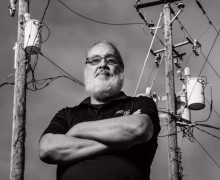Building Connections and Capacity in Indian Country at the First Tribal Wireless Bootcamp
Earlier this summer, a small group of people gathered in the southern California desert for the first Tribal Wireless Bootcamp. Organized by a loose collection of people with a long history of building and encouraging nontraditional broadband networks, the focus was on building, maintaining, and troubleshooting wireless networks in Indian Country.
To avoid any pretense of journalistic integrity, I will just say upfront that it was awesome. Not just in the sense that it was a good time, but in the sense that it was overwhelming and hard to fully grasp. For some of us, it was the first time in more than a year we had been in a group of people of any size, let alone people outside our immediate social circle.
Some of the attendees were already operating networks and others were new to it but everyone shared strategies, whether about software or how to organize people in historically marginalized communities - taking lessons from the Bronx and applying them to Tribal lands.
Ultimately, we achieved the multiple objectives set out from the beginning - to share strategies on building physical networks while actually building a social support network for this work that would endure after the weekend ended. Each of the Tribes involved received a set of 2.5 GHz radios that would not only allow for a high-capacity link, but would standardize the participants so they could better help each other to troubleshoot and improve their networks.
Conception
Many rural areas lack decent broadband Internet access, but the lack of availability in Tribal reservations is extreme. No one even knows what the statistic is, but like many statistics that the Federal Communications Commission publishes, everyone knows it is a gross overstatement. For decades, Tribes have been overlooked, ignored, and defrauded by telecommunications companies seeking to extract wealth from their people and land, with some notable exceptions of companies that have worked hard to connect Indigenous communities. Many Tribal leaders have concluded they need to build their own networks to ensure high-quality Internet access to secure many of the modern benefits the rest of us take for granted.








